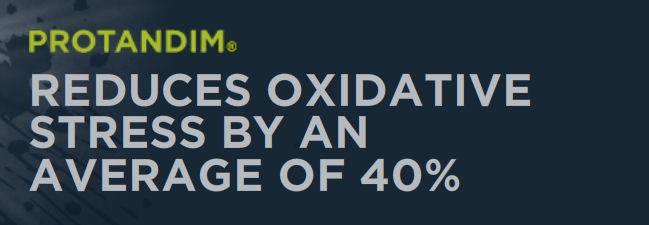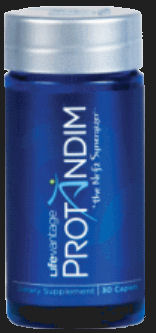

I am not promoting Protandim ... BUT I continue to use it daily !
For More Information contact BJ here
|
Clinical Proof
The induction of human superoxide dismutase and catalase in vivo: A
fundamentally new approach to antioxidant therapy,
Free Radical Biology and Medicine (2006)
The results of a peer-reviewed study (Free Radical Biology and Medicine,
2006) showed Protandim eliminates the age-related increase in cell aging
factors.
In the clinical trials, blood samples from men and women, young and old,
consistently demonstrated that after 30 days, taking one caplet a day,
test subjects realized a 40 percent average decrease in TBARS—the
progressive aging rate of a 20 year old.
When maintained for 120 days, Protandim significantly increased activity
of SOD and CAT antioxid
Click here to view the study. |
PROTANDIM HAS BEEN ISSUED THREE PATENTS AND HAS
BEEN FEATURED ON ABC's PRIMETIME.
|
|
Normal subjects before supplementation with Protandim showed an age-dependent increase in TBARS (blue circles). The levels of TBARS dropped an average of 40% (p<0.0001) after 30 days of Protandim supplementation (green circles), and the age-related increase in TBARS virtually disappeared. This effect (gray circles) was maintained at 120 days with continued Protandim use.
|
University of Colorado Denver Health Medical Center Children's Hospital, Denver Virginia Commonwealth University Colorado State University University of Florida University of Kentucky University of Michigan Louisiana State University Ohio State University Vanderbilt University Glamorgan University, Wales Sahlgrenska University Hospital, Goteborg, Sweden University Hospital, Brno, Czech Republic Mexican Institute of Social Security, Mexico City |
|
Protandim® Found to Prevent a Process that Causes Blood Vessel Blockage in New Peer-Reviewed Study From The Ohio State University Protandim prevents the proliferation of cells that can cause re-blockage of vessels following coronary artery bypass surgery, stenting, and carotid enarterectomy A new peer-reviewed study involving Protandim, sponsored by the American Heart Association and the National Institutes of Health, was published in the scientific journal Free Radical Biology and Medicine. The study, conducted by researchers at The Ohio State University, examined the biochemical mechanisms that underlie the ability of Protandim to suppress intimal hyperplasia (over-proliferation of cells that line the vessel wall), a common adverse event that limits the effectiveness of several types of vascular surgery. Protandim has been shown in earlier studies to activate the transcription factor Nrf2, a signal to the cell's DNA to regulate a network of protective genes. This new study further investigates Protandim's ability to increase production of the body's Nrf2-regulated protective genes, sometimes referred to as "survival genes", which include most of the antioxidant enzymes. The study, titled "Protandim attenuates intimal hyperplasia in human saphenous veins cultured ex vivo via a catalase-dependent pathway" by Binata Joddar, Rashmeet K. Reen, Michael S. Firstenberg, Saradhadevi Varadharaj, Joe M. McCord, Jay L. Zweier, and Keith J. Gooch is published in the journal Free Radical Biology and Medicine and may be found at the following link. For more information read the press release. Chemopreventative Effects of Protandim® Examined Further in New Peer-Reviewed Study Protandim's ability to modulate relationship between superoxide dismutase and tumor suppressor p53 believed responsible for reduction of skin cancers in mice A study, conducted by researchers at Louisiana State University, examined the biochemical mechanisms that underlie the ability of Protandim® to suppress tumors in mice. That ability was previously demonstrated by the authors in a study involving a mouse two-stage model of chemically-induced skin cancer. Protandim®, a patented dietary supplement comprised of five highly synergistic herbal ingredients, has been shown in earlier studies to activate the transcription factor Nrf2, a signal to the cell's DNA to regulate a network of protective genes. This new study further investigates Protandim's® ability to increase production of the body's Nrf2-regulated protective genes, sometimes referred to as "survival genes", specifically in regard to chemoprevention. Click here to view the study. New Peer Reviewed Study Concludes That Protandim® Improves Markers of Oxidative Stress and Fibrosis in Muscular Dystrophy Mice The study, titled The Dietary Supplement Protandim® Decreases Plasma Osteopontin and Improves Markers of Oxidative Stress in Muscular Dystrophy Mdx Mice by M.M. Qureshi, W.C. McClure, N.L. Arevalo, R.E. Rabon, B. Mohr, S.K. Bose, J.M. McCord, and B.S. Tseng, documents a 48% decrease in plasma TBARS, a marker of lipid peroxidation and oxidative stress, a 57% decrease in plasma osteopontin, a fibrosis-promoting factor linked to heart failure, and a 35% increase in beneficial, protective plasma PON1 activity in those mice given Protandim® compared to those without Protandim. PON1 is an enzyme thought to protect against atherosclerosis by preventing the oxidation of low-density lipoprotein (LDL) cholesterol. Click here to view the press release. Prestigious American Heart Association Journal, Circulation, Publishes New Peer-Reviewed Study Involving Protandim® Dr. Norbert Voelkel and researchers at Virginia Commonwealth University (VCU), demonstrated the ability of Protandim, the Company’s patented dietary supplement composed of five highly synergistic “indirect antioxidants”, to protect the heart in a laboratory model of pulmonary hypertension in rats. “We are encouraged by the results of this study, which was independently funded and independently conducted by Dr. Voelkel and his colleagues at VCU,” stated David Brown, President & CEO of LifeVantage. “These results illustrate the unique antioxidant, anti-inflammatory, and anti-fibrotic properties of Protandim. Scientists have long known of the involvement of oxidative stress in disease processes, and this study is a significant example of how oxidative stress affects susceptibility to right heart failure in animals. Although it would be premature to conclude that similar benefits would be seen in humans, these remarkable results open the door to the possibility of future research on pulmonary hypertension and Protandim in humans.” Click here to view the press release. Synergistic induction of heme oxygenase-1 by the components of an antioxidant supplement Protandim, Free Radical Biology and Medicine (2008) Results of a new peer-reviewed study (Free Radical Biology & Medicine, on November 18, 2008) clearly demonstrate that Protandim produces a 300 percent increase in glutathione, which is a key antioxidant and anti-aging factor. In addition, the study shows that Protandim’s synergistic formulation provides more antioxidant power than any food or conventional supplement. Click here to view the study. 2009 Peer Reviewed Study from Louisiana State, PLoS ONE Journal. Peer Reviewed Study from Louisiana State University, "Protandim®, a Fundamentally New Antioxidant Approach in Chemoprevention Using Mouse Two-Stage Skin Carcinogenesis as a Model," Published in PLoS ONE Journal. Click here to view the study. |
Protandim® prevents the proliferation of cells that can cause re-blockage of vessels following coronary artery bypass surgery, stenting, and carotid enarterectomy
SAN DIEGO, Jan. 4, 2011 /PRNewswire/ -- LifeVantage Corporation (OTC Bulletin Board: LFVN), the maker of science-based solutions to oxidative stress, announced today that a new peer-reviewed study involving its flagship product, Protandim®, sponsored by the American Heart Association and the National Institutes of Health, was published in the scientific journal Free Radical Biology and Medicine. The study, conducted by researchers at The Ohio State University, examined the biochemical mechanisms that underlie the ability of Protandim® to suppress intimal hyperplasia (over-proliferation of cells that line the vessel wall), a common adverse event that limits the effectiveness of several types of vascular surgery. Protandim®, a patented dietary supplement comprised of five highly synergistic herbal ingredients, has been shown in earlier studies to activate the transcription factor Nrf2, a signal to the cell's DNA to regulate a network of protective genes. This new study further investigates Protandim's® ability to increase production of the body's Nrf2-regulated protective genes, sometimes referred to as "survival genes", which include most of the antioxidant enzymes.
The study, titled "Protandim attenuates intimal hyperplasia in human saphenous veins cultured ex vivo via a catalase-dependent pathway" by Binata Joddar, Rashmeet K. Reen, Michael S. Firstenberg, Saradhadevi Varadharaj, Joe M. McCord, Jay L. Zweier, and Keith J. Gooch is published in the journal Free Radical Biology and Medicine and may be found at the following link.
Coronary artery bypass graft (CABG) surgery is performed more than 400,000 times a year in the United States. Most procedures requiring multiple bypasses still utilize the saphenous vein (taken from the leg) for secondary grafts. Ten years after CABG surgery, roughly half of the saphenous vein grafts will have become largely, if not completely blocked by processes that may result from intimal hyperplasia. Previous studies concluded that a major factor causing this condition is the three-to-five-fold higher concentration of oxygen experienced by the graft in its new environment. In this study, treatment with Protandim® significantly increased antioxidant enzyme activity in veins cultured at high oxygen, while reducing free radical levels, lipid peroxidation, and, importantly, reducing intimal proliferation to the level seen in a normal healthy saphenous vein.
"This study was conducted in an ex vivo model using human saphenous veins harvested from patients undergoing bypass surgery-the exact population who might benefit from a therapy to prevent intimal hyperplasia," said Dr. McCord, a co-author of the study. "Future animal studies will attempt to demonstrate the ability of Protandim® to block post-surgical intimal hyperplasia in vivo, following not only the CABG procedure, but perhaps angioplasty with stent insertion or carotid endarterectomy, as well. The long-term effectiveness of all three procedures is limited by eventual restenosis, a return of blockage often due to intimal hyperplasia. The three procedures together affect more than 1.5 million Americans every year."
"Protandim® was shown in an earlier human trial to increase antioxidant enzyme production and to eliminate the age-dependent increase in the most widely used marker of oxidative stress. The current study, as well as other recent studies, have shown that Protandim® provides benefits to the body that extend beyond its ability to decrease oxidative stress," stated David Brown, LifeVantage President and CEO. "This study was independently funded by the American Heart Association and by the Heart, Lung, Blood Institute of the National Institutes of Health. LifeVantage greatly appreciates the continuing academic interest in Protandim® shown by researchers such as Dr. Keith Gooch and his colleagues. We continue to be encouraged at the tool that Protandim® has become for researchers of many health conditions associated with oxidative stress."